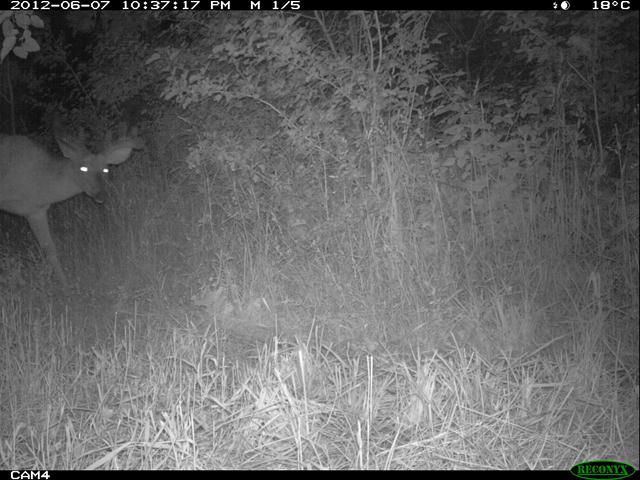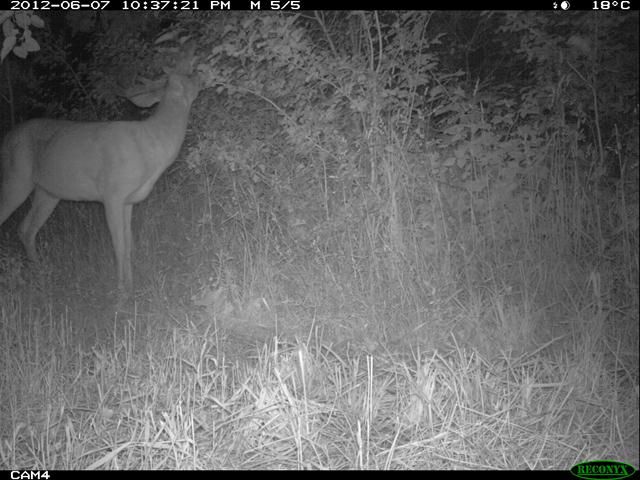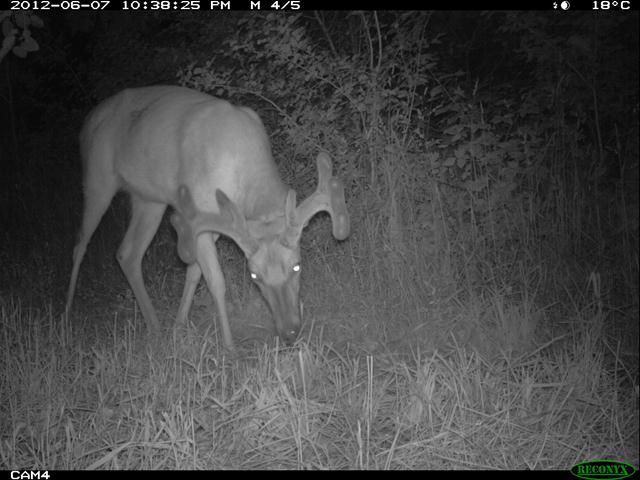This fella's going to be a beauty. In fact, it could be one of the brutes I got pictures of from behind the house last fall (see here, and here) and I'm pretty sure it's the same fella I captured on this camera over a month ago (see here). I guess he survived last year's hunting season (see here and here). Assuming this is the same individual...it seems he's back.
If I were a deer hunter, I'd be salivating.....
____________________________________________________________________________
On 6/12/2012 as we drove home from my daughter's swimming lesson...we saw a Red Fox (Vulpes vulpes/fulva) bound across the road. It was heading into a woodland preserve near campus and as we pulled up, the fox stopped to look at us from the roadside. It held that spot for a good 10 seconds, not 15 yrds away and we saw it had a meal dangling from its jaws. Appeared to be a young Whistlepig (Marmota monax). After a quick look-see, the fox turned and trotted back into the woods. I'm assuming it had pups nearby.




Wow...those are big antlers. I'm interested in why the lower 48 have big antlers and the moose in AK have small! I know its a huge difference in latitude, species, climate, etc etc...but JVN was posting pics from Yellowstone (where he was last week), and the ungulates there, including moose, have large racks already. The bull moose I've seen here have 6-8" spikes!
ReplyDeleteThat is going to be one fine set of antlers!
ReplyDeleteand such a good demonstration of the difference in antlers between white tail and mule deer. I laugh when I see the Deer Crossing signs here in California because the silhouette is of a white tail buck.
ReplyDeleteHey All...
ReplyDeleteAlyssa, there are likely lots of factors that influence why this variation you speak of exists...and I'm not versed in all of them. Also, if you were to talk to ten different folks about this topic you could get 10 different answers! Some will swear up and down that genetics have all to do with antler size. Frequently, after showing folks pictures of bucks with scraggly, or unusual looking racks, I hear the "that one needs to be culled to take his genes out of the population." There are also those that swear up and down that it has to do with the resources available to the animal. Greater resources....more resources available to put into a secondary sexually-selected character (like antlers).
Like I said, I'm not expert...and don't want this to start up a big debate about what's most important....but it has to be some of both (as well as quality of habitat, quality of forage...there's even studies that relate nutrient/mineral content of soils to buck antlter size). So...it could be that the males who "win" male-male contests, and the right to breed, are the males with desireable traits (like large antlers)...so the genes for large antlers are passed on to their offspring. But, there is alot of evidence to support that large antlers occur in high resource environments. Maybe the superior genes are actually those that code for a superior ability to acquire resources (and the antlers are a by-product of that)?
But, what I can tell you about the area where these photos came from: resource availability is very high. It's an agricultural mosaic landscape (lots of edge habitat, which is prime for white-tails, tons of food, and almost no real threat of predation....the biggest thing to worry about for a deer here are cars and humans during the hunting season). I can also tell you that my neighbors swear to me that a state record buck was shot in the area at one time. Perhaps just a story...but still, it means they've seen large bucks previously. If the pictures above are showing the direct descendents of those large bucks seen in the past, that would support the genetics theory (or perhaps there's always been a ton of resources avaialble for deer in his area).
I'm just throwing this out there but....in Yellowstone (and AK) there are Wolves...and cougars...and Bears. Also, deer seemed to be designed to thrive in landscapes with moderate agriculture like we have here (...and my gut feeling is that they thrive in these even moreso than in "pristine" natural habitats). There are also more potential ungulate competitors there: deer, elk, moose, etc.. Here there is basically just deer. I suspect that all of those things work in the deer's favor around here and one reason why we get these huge bucks (and why we have so many deer).
Just some arm-waving on my part....and I need to delve into the literature on this alittle deeper! It's an interesting topic....
18°C at 10:30PM? Staying warm at night already there huh? He is certainly going to be a brute. Hopefully he makes it through another hunting season.
ReplyDeleteFrom what I understand, it is likely both genes and environment that play a role in antler development. Better nutrition leads to more resources for sexual characteristics, but that they need to be genetically "pre-disposed" to utilizing the resources and turning them into large antler growth. This makes a lot of sense to me from a genetic and possibly epigenetic standpoint but the jury is still out and a lot more science needs to be done to figure this out.
However it never totally made sense to me why the hunters love to kill the best animals in the gene pool and lower the quality of animals to hunt in successive years but I guess it is just prisoner's dilemma. If they let the big one live, some one else will just kill it.
We've had some warm days for sure....but it usually only lasts for a day or two, then drops. We had a string of beautiful days (mid to high 70s in the day and into the 50s at night...low humidity).
DeleteBut, late June/July, the humidity kicks in....temps get higher.
...I agree with you totally! Like I said above, it has to be alittle of both (genetics and environment, etc.). But it's interesting....you go on the hunting forums....and you'll often get intense arguments about it being one OR the other.
It's very interesting and thanks for taking the risk to explain, haha...what's been at the back of my mind is it that AK is 'behind' in season? It's just warming up here and the locals aren't calling it summer yet- so in the lower 48, where it is warmer, earlier- the ungulates can "leaf out" earlier? Does that make sense? Do cold temps have anything to do with when antlers bud and grow? Maybe these are rhetorical questions...but I wonder!
DeleteHey Alyssa...
ReplyDeleteMy gut feeling is that what you describe must have something to do with it (assuming that resource availability has large influence on antler growth). So...the warmer temps might not DIRECTLY affect antler growth, but they do affect timing of when vegetation starts to take off. If there are more resources (i.e. food in the form of vegetation) available eariler becuase it's warmer in one area vs. another, it makes sense that antler growth in the warmer area would progress faster due to more food earlier (i.e., temp indirectly affects antler growth).
Again.....factors influencing antler growth is not my area of expertise.....been meaning to look up more of the specifics, but have been in the field constantly (rather than in the office where all of my books are!).
Hope your summer job continues to go well....